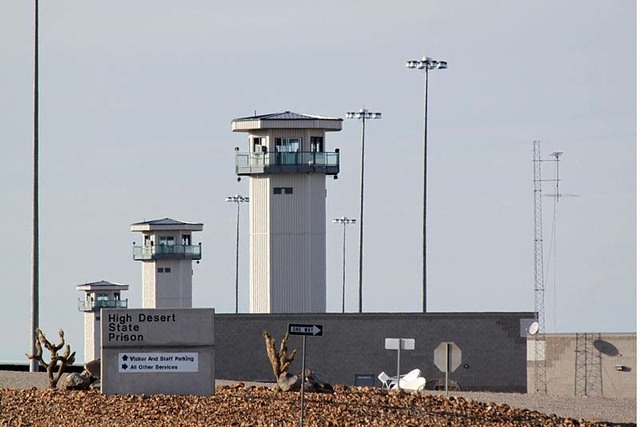Training, equipment sorely lacking for High Desert prison officers
A High Desert State Prison corrections officer trainee drew upon his weeks of experience and fired a shotgun blast Nov. 12, 2014, that killed one brawling inmate and wounded another.
The trainee’s fellow corrections officers began asking questions among themselves even before inmate Andrew Arevalo was hospitalized and the body of Carlos Perez Jr. was hauled to the morgue. (Arevalo’s attorney disputes that birdshot was used in the deadly incident, which became public when first reported in the Review-Journal.)
Blasting birdshot to break up a fight arguably qualifies as extreme by most measures — especially when even small-town law enforcement these days is equipped with intermediary steps before deadly force is used. For some, a PR-24 baton would be called for, or perhaps pepper spray would be deemed appropriate. Even a Taser would be considered preferable to firing a shotgun inside an occupied concrete bunker.
Trouble is, multiple sources say, none of that equipment was available. A shotgun was the only tool at the C.O. trainee’s disposal.
Recent interviews with nine current High Desert corrections officers, who agreed to speak on the condition that they remain anonymous out of a stated concern for their job security, paint a consistently troubling picture about a substantial lack of equipment and training that endangers the safety of both the prison employees and the inmates under their charge.
They have had PR-24 batons, pepper spray and Tasers in the past, but they are no longer commonly available or in use by department directive. They even have some of that equipment still in storage on prison property — they’re just not allowed to use it.
No corrections officer defended the shooting, but each said he understood how the violent situation escalated and the decision was made to fire the weapon. They offered similar views about the inevitability of such an incident taking place inside the prison given the lack of intermediary measures immediately available in a crisis.
“I think he made a mistake, but this was bound to happen,” one veteran corrections officer said. “You can’t help but feel bad for him. He was new and was in over his head.”
“I know what people might think about us, but none of us wants this to happen,” a second added.
“I feel horrible for him,” another said. “He’s got to be drinking right now.”
The identity of the officer who fired the shotgun hasn’t been released. Two other corrections officers, who multiple sources say had less than three years of experience, were in the area during the shooting. Their identities also have been kept confidential.
“Training is a huge part of law enforcement,” one officer said. “We don’t have the tools available to us. Whether it’s the money, or whatever it is, we don’t have it.”
“We’re worried just as the public is,” another said. “What the public needs to know is we don’t have access to the tools.”
One officer said pepper spray was removed from common circulation after it was misused in what was described as a prank. He added that the safety of every corrections officer was put at risk by the decision.
“They spray people in the academy,” one officer recalled.
Another added, “But it doesn’t matter if you never get to use it.”
Officers interviewed complained of receiving far too little in-service training. They agreed they received little training in the use of pepper spray and the Taser and only went to the shooting range a couple times a year.
“Is it true that the reason we don’t have these tools and this training because we don’t have the funding?” one asked. “It might not be the warden’s fault. Maybe the positions were approved but never funded.”
They are, they said, generally the last to know and the first to feel the effects of state budget cuts. That has led to high turnover at High Desert and throughout the state prison system.
All that, they believed, should be considered before passing judgment on the events of Nov. 12, 2014.
“This situation right here was preventable,” one veteran said. “I know you can’t prevent everything, but that would have been an easy takedown … with no (lethal) force.”
As they describe it, all they would have needed were the right tools for the job and the proper training. There’s an ongoing crisis inside High Desert.
If they’re right, some grisly recent history is likely to repeat itself.
John L. Smith’s column appears Sunday, Tuesday, Wednesday, Friday and Saturday. Email him at Smith@reviewjournal.com or call 702-383-0295. Follow him on Twitter: @jlnevadasmith.















